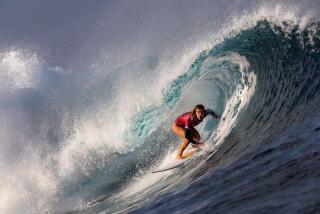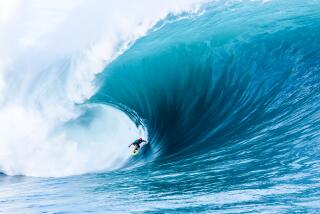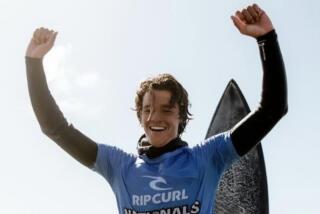Standing Tall in Wave of Shorter Competitors : Surfing’s Cruickshank Going for the Big Ones
- Share via
Mike Cruickshank of Dana Point doesn’t look like a professional surfer. He stands 6-feet tall and weighs 185 pounds. He has a football player’s build and towers over many of his fellow competitors on the Professional Surfing Assn. of America (PSAA) tour.
Cruickshank’s peers have acknowledged this physical disparity. They call him “The Bull.”
“I’m not the lightest person on my feet,” he said. “As far as professional surfers, I’m in the top four as heavy guys. Most of the guys are from 5-4 to 5-9 and weigh from 135 to 160 pounds. They’ve got an advantage over me. They take off on a three-foot wave and I take off on the same wave and it looks bigger with them on it. They’re lucky I don’t weigh 125 pounds.”
Cruickshank’s opponents are not lucky that he is competing, which is another reason for his nickname.
“We all have to give him a lot of credit for his persistence,” said his sister, Kim. “He goes out there and bulls his way through waves.”
Cruickshank, 29, is the kind of competitor who refuses to give up, and he hopes to show his tenacity this weekend in the $12,000 Maui & Sons Classic at Salt Creek County Beach in Laguna Niguel.
The contest is the next-to-last meet in this year’s PSAA tour, with one more contest to be held at Malibu in August. Competition starts Friday at 7 a.m. with qualifying rounds. The finals will be held Sunday.
Cruickshank’s persistence was never more evident than last year, when he qualified for the PSAA championship meet at Huntington Beach Pier. The organization’s best eight surfers were pitted in a meet to select the season’s champion. The PSAA is a group of West Coast touring surfers.
Cruickshank had not fared well most of 1986 but eventually qualified for the PSAA championship.
“All season I would go one or two rounds and that was it,” Cruickshank said. “Only the top two in each heat go on, and I just wasn’t doing that.”
Cruickshank didn’t expect to win the championship--he said he was lucky to be competing.
But he had a good session at Huntington Beach. Instead of being eliminated as he had much of 1986, he kept advancing through his heats, and eventually won the contest for the biggest victory of his career.
“That day everything just came together for me,” he said. “I’ve had luck catching some good waves before, but I was catching them all that day.”
But after that victory and winning the 1987 tour’s first event, the Vuarnet Pro-Am in San Francisco, he hasn’t won since.
“After winning the championship last year and the first event of the season, it’s been hard for me to get pumped up for the rest of them,” Cruickshank said.
“I guess you could say I’ve also had a streak of bad luck, but this (Salt Creek) is my home break. I grew up surfing here and I should do well. I know the reefs, I know where the waves will break on different swells.”
But Cruickshank is seeded No. 8, and will be challenged by No. 1-seeded Mike Lambresi of Carlsbad, No. 2-seeded Scott Daley and No. 3-seeded Jim Hogan of Capistrano Beach.
Cruickshank knows he’s not favored, but, well, what’s new?
“That doesn’t bother me,” he said. “I’ve always been stubborn. I just hang in and don’t give up.”
Such was the case when he went out for swimming at Dana Hills High School. He said he was too slow, but . . .
“I just kept on going,” he said. “I mean I couldn’t beat anyone, but I could swim just as long as anyone on the team.
“Eventually I’d pass them up after about a day or so.”
His persistence has kept him in professional surfing, “a young man’s sport,” for almost a decade.
Cruickshank has been surfing since he was 5 and surfing competitively since he was 10. He became a professional surfer at 20, and says he has not worked at another career.
“The money compared to other sports is petty,” he said. “In 1985 when I was No. 5, I made $1,200 for 18 events. It (costs) more than that just to compete. If a guy wants to follow the tour and live decently, it takes a good $20,000 to live.”
Touring surfers must pay transportation costs unless they are lucky enough to have a sponsor. Cruickshank said many of the PSAA surfers do not compete on the international tour--the Association of Surfing Professionals--because of the costs. The ASP tour receives more publicity and the paychecks are bigger, but the travel costs to such countries as Japan, Australia and South Africa are tremendous.
“I spent $5,000 to go to Australia to compete on the tour and only made $200,” he said.
Such is the life of the struggling pro.
But from the day his father, Malcolm, a surfer in the 1950s, introduced him to the sport, Cruickshank knew he’d stay with it.
Malcolm Cruickshank never competed, but he did appear in a tobacco commercial in the 1960s puffing on a cigar while surfing.
So he encouraged his son to try the sport when they went to Doheny State Beach in Dana Point in the early ‘60s. Malcolm even made his son’s first surfboard.
He took an old broken tandem surfboard and shaped it for a youngster.
“It looked like a bar of soap,” Cruickshank said. “It was 6-feet tall, 5-inches thick with square rails (the sides of the board).”
As an amateur competitor in the now-defunct Western Surfing Assn., Cruickshank won his age division for three straight years.
His first professional title was earned in 1982 when he won the Hang 10 Grand Prix. He also won that event the next year and placed fifth in the 1983 ASP Ocean Pacific Pro in Huntington Beach.
Cruickshank’s surfing career, however, is nearing an end because he believes he’s getting too old to compete against teen-agers.
“What happens is that you get a little bit burned out,” he said. “The surf media puts a lot of attention on the younger guys more than the guys who are 27 or 28. The guy who gets older can still surf hot, but you mentally become tired of it. For me, it became more of a job than enjoyment.”
Cruickshank is regaining his enthusiasm. The reason? He’s got a career-oriented job working for a surf wear company in Fountain Valley.
“Since I started to work (last August), all my free time has been taken away from me. I now find I really crave it. I want to surf more and am enjoying it more. I don’t take it for granted anymore.”
He plans to compete for another couple of years, refusing to put a time limit on his retirement. Then, he says, perhaps he’ll do what his father used to do.
“He wouldn’t take just any wave,” Cruickshank said. “My father liked to go for the big ones only, so he really couldn’t compete because you have to take what you can when you do.
“I think that’s what I’ll do. Go for the big ones.”
More to Read
Go beyond the scoreboard
Get the latest on L.A.'s teams in the daily Sports Report newsletter.
You may occasionally receive promotional content from the Los Angeles Times.










